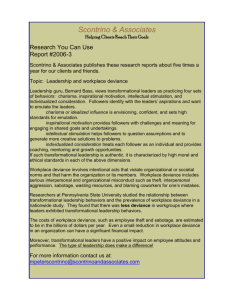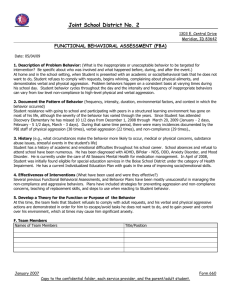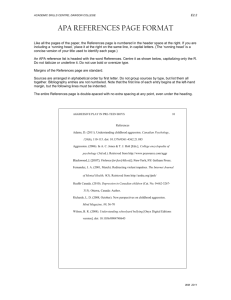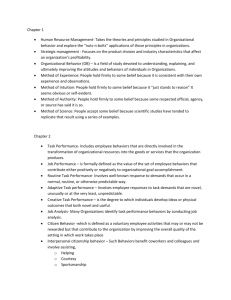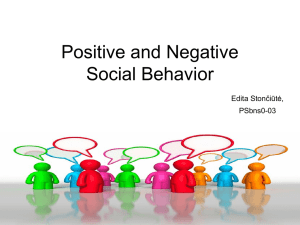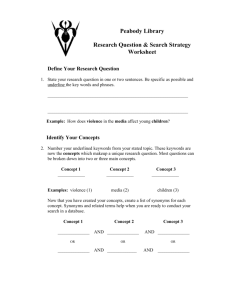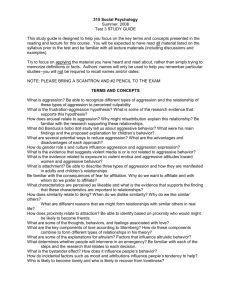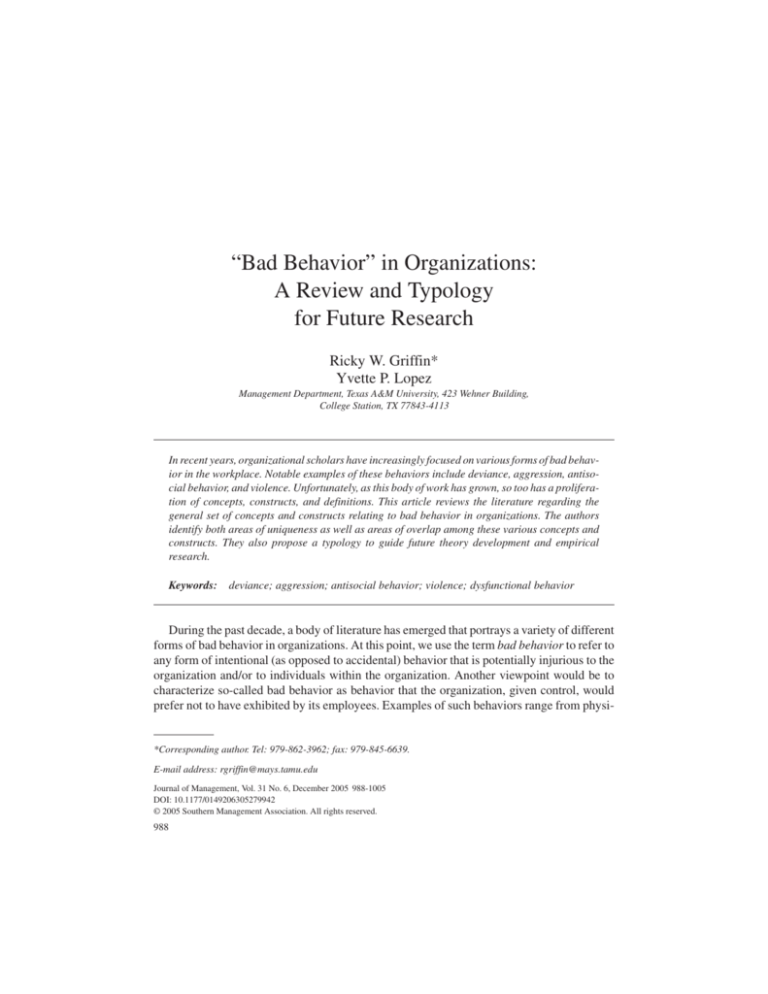
Journal of
ARTICLE
10.1177/0149206305279942
Griffin,
Lopez
Management
/ “Bad Behavior”
/ December
in Organizations
2005
“Bad Behavior” in Organizations:
A Review and Typology
for Future Research
Ricky W. Griffin*
Yvette P. Lopez
Management Department, Texas A&M University, 423 Wehner Building,
College Station, TX 77843-4113
In recent years, organizational scholars have increasingly focused on various forms of bad behavior in the workplace. Notable examples of these behaviors include deviance, aggression, antisocial behavior, and violence. Unfortunately, as this body of work has grown, so too has a proliferation of concepts, constructs, and definitions. This article reviews the literature regarding the
general set of concepts and constructs relating to bad behavior in organizations. The authors
identify both areas of uniqueness as well as areas of overlap among these various concepts and
constructs. They also propose a typology to guide future theory development and empirical
research.
Keywords:
deviance; aggression; antisocial behavior; violence; dysfunctional behavior
During the past decade, a body of literature has emerged that portrays a variety of different
forms of bad behavior in organizations. At this point, we use the term bad behavior to refer to
any form of intentional (as opposed to accidental) behavior that is potentially injurious to the
organization and/or to individuals within the organization. Another viewpoint would be to
characterize so-called bad behavior as behavior that the organization, given control, would
prefer not to have exhibited by its employees. Examples of such behaviors range from physi-
*Corresponding author. Tel: 979-862-3962; fax: 979-845-6639.
E-mail address: rgriffin@mays.tamu.edu
Journal of Management, Vol. 31 No. 6, December 2005 988-1005
DOI: 10.1177/0149206305279942
© 2005 Southern Management Association. All rights reserved.
988
Griffin, Lopez / “Bad Behavior” in Organizations
989
cal violence to sabotage and theft to verbal abuse to counterproductive political activity (cf.
Griffin & O’Leary-Kelly, 2004).
Unfortunately, as this body of work has emerged, so too has a proliferation of concepts,
constructs, and definitions. It might even be argued that the wide array of approaches taken to
date regarding bad behavior may be on the verge of impeding further theoretical development
and empirical research. For example, deviance, aggression, antisocial behavior, violence, dysfunctional behavior, abuse, incivility, and misbehavior are all examples of constructs that have
formed the basis for published research in the past decade. In many cases, however, the distinctions between these constructs are ambiguous or unspecified. Consequently, even subtle
differences in how concepts are implicitly or explicitly defined and/or conceptualized may
result in contradictory and/or incongruent theoretical arguments and empirical conclusions.
Our purpose in undertaking this work is twofold. First, we will review the literature on a
general set of concepts and constructs relating to bad behavior in organizations. Second, we
will then identify areas of uniqueness and areas of overlap among these various concepts and
constructs. Finally, we assess the theoretical clarity of each behavior and then propose a
typology to guide future theory development and empirical research.
Forms of Bad Behavior in Organizations
Many forms of bad behavior of current interest to organizational scholars have roots that
can be traced back for decades. For instance, by definition, the concept of deviance derives
from earlier work on group norms (cf. Davis, 1964; Feldman, 1984; Sherif & Sherif, 1953).
However, we focus primarily on the past 10 years of work because it is during this period that
most current formulations of bad behavior have been proposed and brought into the contemporary mainstream. In addition, we also concentrate on research associated with organizational settings. That is, for example, we include work dealing with aggression in the workplace
but not aggression in other settings.
Furthermore, we focus primarily on four central forms of bad behavior in organizations:
deviance, aggression, antisocial behavior, and violence. We make this choice because it is
these four areas that have received the preponderance of attention by organizational scholars.
It is also among these behaviors that the greatest likelihood exists for theoretical and operational confusion and ambiguity. Other related concepts such as incivility, workplace abuse,
destructive work behavior, noncompliant behavior, organizational misbehavior, and bullying
are found in the literature, but there does not yet exist a substantial body of work regarding any
of them.
Moreover, we also exclude other forms of behavior that are best addressed in terms of legality—employee theft, criminal negligence, discrimination, sexual harassment, industrial espionage, and so forth. These behaviors have been defined by our legal system and are almost
always assessed and punished (as appropriate) by that system. Finally, we also exclude those
behaviors that might be seen as undesirable by the organization, such as whistle-blowing, but
that may provide social benefits.
Inherent in any such classification scheme are ethical and value-driven distinctions about
what indeed reflects goodness versus badness. We acknowledge that for our current purposes,
990
Journal of Management / December 2005
we do not directly address these issues. However, we do see them as being very significant and
worthy of additional consideration in their own right. Our boundaries reflect the points made
earlier regarding intentionality and injury—behaviors that are intentional and that may cause
injury. For purposes of this analysis, we implicitly use normative perspectives to reflect the
nature of both intentions and injury. For instance, most observers would agree that although
whistle-blowing might result in injury to an organization, that injury is justified insofar as the
organization was guilty of some act that was harmful to others.
Workplace Deviance
Drawing on earlier work regarding group norms, the concept of workplace deviance (i.e.
deviance from norms) was recently reframed as a significant organizational construct by Robinson and Bennett (1995). These authors define workplace deviance as voluntary behavior
that violates significant organizational norms and in so doing threatens the well-being of an
organization, its members, or both. Furthermore, they both implicitly and explicitly see deviance as a form of bad behavior. This definition and perspective are carried forward in several
subsequent articles dealing with deviance (cf. Bennett & Robinson, 2000; Colbert, Mount,
Harter, Witt, & Barrick, 2004; Dunlop & Lee, 2004; Elangovan & Shapiro, 1998; Lee & Allen,
2002; Peterson, 2002; Robinson & Greenberg, 1998).
More recently, Warren (2003) has extended the concept of workplace deviance by first
defining the construct in a more neutral manner as simply being a departure from norms. This
perspective actually reconnects the concept of deviance from norms with earlier theoretical
work (cf. Sherif & Sherif, 1953). With this viewpoint as a foundation, Warren then frames convincing arguments that although some forms of deviance (termed destructive deviance) are
indeed negative, others (called constructive deviance) are actually positive behaviors that can
potentially benefit the organization, its members, or both. For instance, if the strongly held
work norms of a group encourage selfish behaviors and discourage various cooperative and
team-oriented behaviors that the organization would prefer, deviance targeted at changing
these norms might be beneficial to the organization, the work group itself, and some or all of
the group’s members.
Workplace Aggression
Aggression has a substantial intellectual heritage (cf. Bandura, 1973). For instance, aggression has been studied, documented, and debated in the fields of child development, political
science, sociology, criminal justice, anthropology, psychology, social psychology, and several
other disciplines. However, its relevance and application to organizational work settings is relatively new. There are two different but not incompatible definitions of aggression that have
emerged as commonly used perspectives in the organizational literature.
The Neuman and Baron perspective. Neuman and Baron (1998) used the term workplace
aggression to encompass all forms of behavior by which individuals attempt to harm others at
Griffin, Lopez / “Bad Behavior” in Organizations
991
work or their organizations. These authors later extended their thinking by describing five
forms of aggression: covert aggression, overt aggression, verbal aggression, obstructionism,
and workplace violence (Baron & Neuman, 1998). This approach to aggression has also been
used by Glomb and Liao (2003); Dietz, Robinson, Folger, Baron, and Schultz (2003); Jawahar
(2002); and Kennedy, Homant, and Homant (2004).
The O’Leary-Kelly, Griffin, and Glew perspective. A somewhat different approach to
workplace aggression has been developed by O’Leary-Kelly, Griffin, and Glew (1996).
Using the work of Bandura (1973) as context, these authors introduced the term organizationmotivated aggression, defined as an attempted injurious or destructive behavior initiated by
either an organizational insider or outsider that is instigated by some factor in the organizational
context. That is, aggression is seen as a specific behavior or set of behaviors by an individual in
an organization. This aggression is also seen as resulting from a stimulus in the organization,
such as a perceived injustice or some extreme stressor such as being terminated or demoted.
O’Leary-Kelly et al. (1996) continued to differentiate this construct from organizationmotivated violence, which they defined as the significant negative effects on a person or property that occur as a result of organization-motivated aggression. Hence, although aggression is
seen as a behavior, violence is seen as the consequence of that behavior. A terminated
employee may feel justified in attempting to assault the manager responsible for the termination (aggression); the effects of the attempted assault may be physical injury (violence). Tobin
(2001) and Aquino and Bradfield (2000) are among the researchers who have used this
perspective in their own work.
Although these two perspectives are not incompatible, there are some fundamental differences between them. For one thing, the Neuman perspective subsumes violence as a form of
aggression, whereas the O’Leary-Kelly et al. viewpoint assumes that violence results from
aggression (and is therefore a different construct). In addition, Neuman, Baron, and colleagues do not focus on the causes of aggression per se but are instead primarily concerned
with various forms, dimensions, and/or targets of aggressive behavior. O’Leary-Kelly, Griffin, and colleagues, meanwhile, cast their discussion of organization-motivated aggression
specifically in terms of its causes—behaviors that are instigated by some factor in the
organizational context.
Antisocial Behavior
As with deviance and aggression, the concept of antisocial work behavior can be traced
back several decades (cf. Festinger, 1950). However, it was the more recent work of Giacalone
and Greenberg (1997) that brought the concept back into the contemporary mainstream. Antisocial behavior is defined as any behavior that brings harm, or is intended to bring harm, to an
organization, its employees, or its stakeholders. It is juxtaposed as the theoretical antithesis of
prosocial behavior—behavior intended to help others and/or to accomplish positive outcomes. Most researchers who have addressed antisocial behavior have adopted perspectives
or definitions consistent with, or the same as, this point of view.
992
Journal of Management / December 2005
For example, Robinson and O’Leary-Kelly (1998) defined antisocial behavior simply as
negative behaviors in organizations. Aquino and Douglas (2003) referenced this same perspective in their work, as did O’Leary-Kelly and Newman (2003). Meanwhile, Elangovan and
Shapiro (1998) used the formulation of the construct as presented by Giacalone and
Greenberg (1997).
Workplace Violence
Finally, the fourth substantive construct we address is workplace violence. Not surprisingly, given the generally understood meaning of the term, definitions and perspectives associated with violence are relatively consistent and straightforward. For example, Neuman and
Baron (1998) defined workplace violence as an instance involving direct physical assault.
They also characterized violence, as noted earlier, as the most extreme form of aggression.
LeBlanc and Kelloway (2002) described workplace violence as physical assaults and threats
of assault directed toward employees. And Greenberg and Barling (1999) defined workplace
violence as an act carried out with the intention, or perceived intention, of causing physical
pain or injury to another person. Recall, however, the distinction made between aggression
and violence (seen as the result of aggression) previously noted in the work of O’Leary-Kelly
et al. (1996).
Interestingly, and no doubt attributable to the general widespread agreement on the meaning of violence, many researchers who address workplace violence do not even bother to actually define it in their work, apparently assuming that it has common meaning. For example,
among numerous others, Wade (2004); Blythe and Stivarius (2004); Camardella (2002);
Zugelder, Champagne, and Maurer (2000); and Johnson and Indvik (1994) all presented
cogent discussions and examinations of the subject of workplace violence without ever
explicitly defining the term.
Similarities and Differences Among Central Constructs
We now turn to an analysis of the substantive similarities, differences, and related issues
among the central constructs of deviance, aggression, antisocial behavior, and violence. The
dimensions we use to frame this analysis are definitional precision, temporal consistency, construct dimensionality, behavioral motives, and behavioral consequences. These dimensions
are chosen because they contribute in meaningful ways to our ability to identify substantive
similarities and differences among constructs and to frame meaningful directions for future
theory and research.
Definitional Precision
Definitional precision is often a problem in organizational research. In some cases, for
instance, researchers modify existing definitions to best fit their own research objectives. Subsequently, the original definition may get modified several times, resulting in a proliferation of
Griffin, Lopez / “Bad Behavior” in Organizations
993
slightly different definitions for what is intended to be the same construct. In other cases, they
create or introduce new terms without a precise explication of boundary conditions. As a
result, definitional precision (at a minimum) and/or construct validity (more significantly)
may suffer.
A review of the definitions of the four central constructs of bad behavior reflects this precision problem. For instance, each of the four constructs has been portrayed as a unique concept
that, although related to other concepts, is also sufficiently different from them so as to warrant
its own terminology. Table 1 presents a summary of the primary definitions of each construct,
as introduced previously. Common to all four concepts are the implicit and/or explicit elements of threats and harm. Hence, the four constructs clearly encompass these elements. But
each also at least purports to have some unique perspective as well.
To compound the issue of definitional precision even more, Table 1 also presents common
lay definitions for each of these constructs. There are clearly several differences between the
scholarly perspectives and lay definitions. This issue is important, given an assumed goal of
helping practicing managers better understand the underlying behavioral issues and potential
implications for preventing bad behaviors and their consequences in organizations. Of course,
some of these differences are already being addressed. For instance, the refinement of the
deviance construct by Warren (2003), as discussed earlier, clearly brings that construct more
in line with conventional lay uses for the word deviance.
In other cases, however, more parsimony between scholarly and lay meanings might be
desirable. Aggression poses a very clear example. In the academic literature, aggression is
almost universally used in a negative context. In practice, however, managers often characterize someone as aggressive with an associated positive meaning. As noted in Table 1, for
instance, a secondary definition of aggressive is assertive, bold, and enterprising. Hence, an
executive who is willing to make risky decisions, who strongly communicates an ambitious
agenda for the organization, and who actively seeks innovative and unusual methods for surmounting obstacles might very well be seen by others as aggressive, but in a very positive way.
Likewise, scholars also use the term antisocial behavior with strictly negative connotations. In social settings, however, someone who is introverted and/or does not care to socialize
with colleagues outside the workplace might be called antisocial by others in the organization.
Although this reference is not likely to be used in a positive manner, it is also generally not as
negative as the scholarly meaning; that is, the scholarly meaning reflects undesirable actions
directed at others, whereas the lay meaning is often more passive or neutral in nature. In addition, the lay definitions of antisocial behavior are also consistent with the deviance concept as
refined by Warren (2003)—behaviors that do not follow social norms.
Temporal Consistency
Another dimension for assessing bad behaviors is their temporal consistency. By this, we
mean the extent to which any given behavior is or can be maintained over time by an individual. In effect, most scholars have treated bad behaviors as present or absent, without considering the extent to which any given behavior can be maintained or repeated. In reality, it is likely
that some forms of bad behavior can actually be maintained for an extended period of time,
994
Journal of Management / December 2005
Table 1
Scholarly Versus Lay Definitions of Key Bad Behaviors
Behavior
Scholarly Definitions
a
Lay Definitions
Deviance
“Voluntary behavior that violates
significant organizational norms and in
so doing threatens the well being of an
organization, its members, or both”
(Robinson & Bennett, 1995)
Behaviors and attitudes that differ from
accepted social standards
Aggression
“Behavior by which individuals
attempt to harm others at work or
their organizations” (Neuman
& Baron, 1998)
1. Inclined to behave in a hostile fashion.
2. Assertive, bold, and enterprising
Antisocial behavior
1. Shunning the society of others; not
“Actions directed towards other
sociable
employees or the organization that
2. Hostile to or disruptive of the established
have the potential for producing
social order
physical, economic, psychological, or
emotional harm” (Robinson & O’LearyKelly, 1998)
Violence
“Instances involving direct physical
assaults (an extreme form of aggression)” (Neuman & Baron, 1998)
1. Physical force exerted for the purpose of
violating, damaging, or abusing
2. The act or an instance of violent action or
behavior
3. Abusive or unjust exercise of power
a. Lay definitions are taken from The American Heritage Dictionary of the English Language, 3rd ed. (1992).
whereas other forms can only be of a very short duration. For instance, very mild forms of
deviance (constructive or destructive) may be tolerated by others for extended periods of time;
however, a coworker who brandishes a weapon and threatens to hurt someone will no doubt
incur severe organizational and legal sanctions in very short order.
Others in the organization may also be willing to make allowances for various bad behaviors because of awareness or perceptions of extenuating circumstances. For instance, suppose
a coworker is known to be going through some severe personal problems. As a result, the individual is often irritable and occasionally hostile to others at work (likely to be seen as aggression) and uninterested in socializing with coworkers (frequently referred to as being antisocial). Coworkers may, in fact, be willing to tolerate these behaviors far longer than would be
the case without the extenuating circumstances. In general, it might be inferred, then, that various forms of deviance, aggression, and antisocial behavior may be tolerated for some period
of time (affected by circumstances and intensity). Violence, however, is much less likely to be
tolerated for even brief periods.
There are clear implications for the concept of temporal consistency as we use it here that
can be drawn from attribution theory (cf. Kelley, 1971). For instance, attribution theory posits
that people observe and then assess behavior in terms of consensus, consistency, and distinctiveness. Observers then make attributions as to the cause of that behavior. So, as it relates
Griffin, Lopez / “Bad Behavior” in Organizations
995
here, it seems that the extent to which observers see the behavior of someone as being truly
deviant, aggressive, or antisocial could largely be explained in terms of the degree of consensus, consistency, and distinctiveness associated with that behavior.
Construct Dimensionality
Construct dimensionality refers to the potential that the primary construct is, in fact, composed of multiple subconstructs. As noted earlier, for instance, it has been argued that the deviance construct actually consists of two dimensions, constructive deviance and destructive
deviance (Warren, 2003). Likewise, aggression has been portrayed as consisting of overt
aggression, covert aggression, verbal aggression, obstructionism, and violence (Baron &
Neuman, 1998). In addition, as noted in the Definitional Precision section, it may also be possible to argue that, like deviance, aggression may actually be either positive or negative.
The antisocial behavior construct is also clearly multidimensional in nature, although most
efforts to describe its components have been general in nature. O’Leary-Kelly and Newman
(2003), for instance, characterized antisocial behavior as including negative behaviors that are
both verbal and physical, severe and less severe, and that are directed at a wide array of targets.
Interestingly, although there is perhaps the most consistency between scholarly and lay definitions of violence, there has been relatively little discussion in the literature regarding different
forms of violence. It is relatively simple, however, to identify an array of violent acts that can
occur in organizational settings, including physical assault, sexual assault, assault with a
deadly weapon, and violence against property. Less commonly addressed in the academic literature are such other forms of violence as verbal assault and similar abuses of power.
Behavioral Motives
In virtually all cases, researchers studying bad behaviors have focused almost exclusively
on the behaviors themselves. Although there are occasionally references to the causes of such
behavior, there have been few detailed discussions and virtually no in-depth analyses of why
individuals elect to pursue behaviors that the scholarly community, at least, would classify as
undesirable. Indeed, although only the Robinson and Bennett (1995) definition of deviance
describes the target behavior to be voluntary, the other central constructs under discussion
here certainly imply that individuals elect to engage in relevant behaviors. Hence, it is perhaps
worthwhile to focus attention on the intentions of those identified as engaging in bad behaviors. We will consider such intentions from the points of view of motivation, complexity, and
transparency.
Motivational intent. What factors might motivate individuals to engage in deviant, aggressive, antisocial, and/or violent behaviors? There are actually a number of factors that can be
readily identified. From the perspective of common academic definitions that assume that
such behaviors are bad, their origins may be pathological in nature (i.e., associated with some
mental or psychological illness). They may also be brought about by stress and/or perceived
996
Journal of Management / December 2005
injustice (cf. Neuman, 2004). The felt need for revenge or retaliation in response to an action
by someone else (real or imagined) can also be seen as an obvious trigger for various forms of
bad behavior (cf. Skarlicki & Folger, 2004).
Less commonly addressed, however, are those instances in which what is classified as a bad
behavior by the academic community definitions might, in fact, be motivated by a desire to
help or otherwise benefit the organization and/or its employees. Consider, for example, a talented and hardworking employee transferred to membership in another work group. In addition, suppose that this work group has strongly held norms reinforcing a leisurely work pace
and social behaviors that are clearly contrary to the organization’s goals (such as ridiculing
company announcements, ignoring company events, and so forth). The newcomer to the
group might intentionally—and for valid reasons—engage in deviant and antisocial behaviors
toward other group members. He or she might also be aggressive in efforts to alter the group’s
norms, make management aware of the situation, and otherwise promote what the
organization would see as a beneficial and healthy agenda.
Complexity of intent. It also seems to be the case that any given behavior is likely to have
multiple intentions. It is therefore necessary to make a more comprehensive and detailed
assessment of bad behavior to develop a sufficiently rich understanding of its origins. The
basic premise of this argument is that an individual choosing to enact any given behavior may
actually be pursuing multiple motives simultaneously. Moreover, these various motives may
be uniformly positive, uniformly negative, or some combination of positive and negative.
Again, an example is instructive. Suppose the top manager of one division of a big company has made several poor decisions, is not respected by her or his colleagues and subordinates, and is hampering the company’s overall performance. However, for political reasons,
corporate management is unwilling to take action as long as the division’s performance does
not slide further. A senior manager within the division, however, understands what is going on
and resorts to various bad behaviors to make it imperative that the top manager be forced out.
A variety of motives might have instigated this situation, including the belief that it was for the
good of the company; however, the senior manager may also have understood that he or she
would likely be promoted to the top spot. And perhaps the senior manager had a long-standing
grudge against the top manager. Hence, the desire to the help the company, the goal of obtaining a promotion, and the opportunity for revenge may all have played a role.
Transparency of intent. Finally, it is also instructive to consider the extent to which the
intention is transparent, or clear, to others in the organization. A disgruntled employee who
brings a weapon to work with the goal of shooting his or her boss has very clear—that is, transparent—intentions. However, the transparency of other behaviors is much more opaque. In
many cases, for instance, the distinction between constructive versus destructive deviance
may not be obvious to observers. There may be an understanding within a group that a given
behavior is deviant, but group members may not be able to discern the actual intent of that
behavior.
For example, if a group has a norm that its collective performance is more important than
the performance of any one member, behaviors intended to achieve high individual perfor-
Griffin, Lopez / “Bad Behavior” in Organizations
997
mance will be seen as deviant. However, if a group member begins to engage in such individually focused behavior, other members may develop several different possible reasons: The
individual may be trying to change the norm, the individual may be angry with others and trying to get even, the individual may need additional income and see personal performance as
the best strategy, and so forth. Indeed, as noted above, there may actually be multiple intentions underlying a given deviant behavior. Attribution theory, again, may also play a significant role in how these actions are interpreted by others.
Behavioral Consequences
As with behavioral intention, relatively little attention is generally devoted to issues associated with the consequences of various behaviors. That is, what are the consequences of bad
behavior, and what are the implications of those consequences? Hence, we turn now to the rich
array of potential questions and issues surrounding behavioral consequences with a discussion of the successful enactment of intended behaviors, the complexity of consequences, the
transparency of consequences, and organizational and social responses.
Successful enactment of intended behaviors. A major issue associated with bad behavior is
the extent to which the actor (i.e., the individual enacting the behavior) successfully completes
the behavior as intended. In some cases, true enactment will be very significant; in other cases,
it will be less significant. For example, if the actor’s intention is to shoot a coworker, the discovery of the intention itself will be sufficient to cause major repercussions. If the actor is disarmed before shooting, misses the intended victim, or inflicts only a minor flesh wound on the
intended victim, he or she will nevertheless face loss of employment, social stigma, and almost
certain imprisonment.
In other cases, though, the realization (or lack of) intended consequences may render the
behavior moot or irrelevant. An attempt at verbal aggression, for instance, may result in a
response of even harsher verbal aggression from the intended target. Consequently, the outcome of the enacted behavior may be quite different from what was intended. Similarly, an
attempt to demonstrate deviance from norms may be met with indifference or sufficient ridicule from others that the deviant behavior itself becomes farcical. If the behavior enacted by
the individual is intended to produce a positive outcome, the extent to which that outcome is
achieved can also shed meaningful insights on these behavior patterns. Going back to an
example used earlier, if a productive employee is able to alter the low-performance norms of a
work group, then a positive benefit will have been realized.
Complexity of consequences. As with behavioral intentions, the consequences of bad
behaviors can also be very complex. Given that any given behavior may elicit numerous
responses, it follows logically that those responses themselves may reflect an array of qualities. An attempted physical assault in the workplace, for example, may result in the termination of a disruptive and low-performing employee (the person attempting the assault), the loss
of a valued and high-performing employee who needs the psychological security of a new
998
Journal of Management / December 2005
workplace (the intended victim), the installation of a new emergency response procedure
within the organization, and the adoption of improved employee selection and assessment
techniques.
Likewise, constructive deviance may lead to enhanced work methods, improved decision
making, and better overall performance. However, it may also alienate individuals who were
actually predisposed to accept alternative—and perhaps less polarizing—methods of persuasion and simultaneously establish a belief system that rejecting group norms will henceforth
be valued and rewarded. Hence, it seems likely that regardless of intent, there may be a
complex array of consequences.
Transparency of consequences. By transparency of consequences in this context, we refer
to the extent to which individuals aware of the bad behaviors will recognize and understand
the various consequences that follow from that behavior. Suppose an individual is perceived
by some to have behaved in an inappropriately aggressive manner in order to make a colleague
look bad and further engages in antisocial behavior in an effort to get that individual fired. If
the colleague is subsequently terminated, it may be inferred that the organization was
“tricked” by the aggressive individual. In reality, though, the colleague may have actually
been a poor performer and scheduled for termination even before the aggressive incident
occurred.
Organizational and social responses. Finally, few academicians have focused much attention on the ramifications of bad behavior—the significance of how the organization responds.
If a person engages in destructive deviance and negative aggression, for example, and no sanctions are imposed, the message to others may be that those behaviors are acceptable to the
organization. Likewise, regardless of whether deviant behavior is intended to be destructive or
constructive, the extent to which the social network most relevant to that behavior tolerates or
rejects the deviant behavior may carry profound implications for both the actor and others in
the group.
Theoretical Clarity of Bad Behaviors
Table 2 summarizes our view of the theoretical clarity of each of the four forms of bad
behavior under consideration relative to the five dimensions of definitional precision, temporal consistency, construct dimensionality, behavioral motives, and behavioral consequences.
To the extent to which a given behavior relates in a relatively straightforward and unambiguous manner to a given dimension, we classify it as having theoretical clarity and use the term
clear to make this indication. However, if a given behavior does not relate in a relatively
straightforward and unambiguous manner to a given dimension, we classify it as not having
theoretical clarity and use the term unclear to make this distinction.
On the basis of our review and evaluation of the extant literature, we see the behavior of
workplace deviance as being relatively clear in terms of its definitional precision and construct
dimensionality. In its most current version, deviance is described in relatively precise terms as
relating to norms and comprising the two dimensions of constructive and destructive devi-
Griffin, Lopez / “Bad Behavior” in Organizations
999
Table 2
Theoretical Clarity of Bad Behaviors
Dimension
Deviance
Aggression
Antisocial
Behavior
Workplace
Violence
Definitional precision
Temporal consistency
Construct dimensionality
Behavioral motivation
Behavioral consequences
Clear
Unclear
Clear
Unclear
Unclear
Unclear
Unclear
Clear
Unclear
Unclear
Unclear
Unclear
Unclear
Unclear
Unclear
Clear
Clear
Unclear
Clear
Clear
Note: “Unclear” may indicate ambiguity and/or a lack of specification.
ance. On the other hand, to date, scholars have not addressed the issues of temporal consistency, behavioral motives, and behavioral consequences in a straightforward manner, and so
we see the theoretical clarity of deviance as being unclear on these dimensions. However,
given the existing clarity of the meaning and dimensionality of the construct itself, it seems to
be a fairly obvious next step to address the issues of timing, intent, and consequences.
Aggression has slightly less theoretical clarity. This is perhaps unexpected, given the large
body of work that exists across various disciplines related to aggressive behavior. We see
aggression as having some degree of theoretical clarity only in terms of its construct
dimensionality. Heretofore, the dimensionality of aggression has seldom been addressed by
organizational researchers, with only Baron and Neuman (1998) clearly specifying multiple
dimensions. However, we also see the simpler approach previewed here that would parallel
deviance by describing aggression as being constructive or destructive as having the potential
to enhance the theoretical precision of the aggression construct. On the other hand, we see
aggression as not relating in a clear manner to definitional precision, temporal consistency,
behavioral motives, and behavioral consequences.
We see antisocial behavior has having the least overall theoretical clarity. Indeed, our
assessment suggests that antisocial behavior does not relate in a clear way to any of the five
dimensions. Definitions and presumed dimensionality vary widely across studies, and the
issues of temporal consistency, behavioral motives, and behavioral consequences are only
hinted at by most scholars in this area. Perhaps this is attributable to the fact that antisocial
behavior was not precisely defined as it was being reframed by contemporary scholars, hence
making it relatively easy for researchers to adopt their own implicit definitions and/or
dimensionality to meet the needs of their own work.
In contrast, we see the concept of violence as having the most theoretical precision. Specifically, in our opinion, violence relates very well theoretically to the dimensions of definitional
precision, temporal consistency, behavioral motives, and behavioral consequences. We see it
as relating in an unclear way only to construct dimensionality. Even here, however, although
we classify violence as unclear, we also see addressing this shortcoming as being a somewhat
straightforward undertaking (as will be seen later).
In summary, then, using the five dimensions of definitional precision, temporary consistency, construct dimensionality, behavioral motives, and behavioral consequences in our
1000
Journal of Management / December 2005
assessment, violence has the most theoretical clarity and antisocial behavior the least theoretical clarity. We also see deviance as being somewhat clear theoretically, with aggression as
being somewhat unclear. In our next section, we propose an organizing typology that may
allow organizational scientists to move forward in a more unified direction.
An Organizing Typology of Bad Behaviors
Our discussion seems to provide reasonably clear evidence that although a growing body of
important work dealing with bad behavior in organizations has been compiled, much remains
to be done. Specifically, the current body of work needs greater definitional precision and
more systematic analysis and refinement of issues associated with temporal consistency, construct dimensionality, behavioral intentions, and behavioral consequences. In this section,
therefore, we outline an organizing framework we believe can serve as a blueprint for future
theory and research in this area.
Dysfunctional Behavior
Table 3 summarizes a proposed set of definitions and dimensions for each of the central
behaviors reviewed here. First, we propose that the term dysfunctional behavior be used as the
umbrella term under which other forms of bad behavior are subsumed. The advantages to the
use of this term include the following: (a) It clearly conveys the negative connotations of the
associated behaviors, (b) it does not have a generally accepted lay meaning that conflicts with
the proposed scholarly definition, and (c) it is not yet associated with any specific form of
behavior and thus fits the ideal model of a general categorization of objects (in this case,
behaviors). As noted, we propose the definition of dysfunctional behavior to be motivated
behavior by an employee or group of employees that is intended to have negative consequences for another individual and/or group, and/or the organization itself.
Workplace Deviance and Aggression
We further propose that workplace deviance, aggression, and violence be seen as major
related but distinct forms of dysfunctional behavior. Workplace deviance is defined in Table 3
in a manner consistent with Warren (2003) and acknowledges two forms of deviance, one
destructive and the other constructive (noted in Table 3 as the functional analog to destructive
deviance). A major departure from prevailing thinking reflected in Table 3 is the proposed
conceptualization of workplace aggression. Specifically, we propose that workplace aggression be defined as highly assertive nonphysical behavior directed toward a person or object.
We further propose that aggression be seen as comprising destructive aggression and constructive aggression seen as a parallel configuration to the two forms of deviance.
We use the phrasing highly assertive to distinguish aggressive behaviors from milder forms
of proactive behavior. For instance, asking for a pay raise in a reasoned and professional manner might be seen as proactive; demanding a pay raise in a rude manner and/or under threat of
Griffin, Lopez / “Bad Behavior” in Organizations
1001
Table 3
Proposed Standard Definitions for Bad Behaviors
Behavior
Proposed Definition and Forms
Dysfunctional behavior
Motivated behavior by an employee or group of employees that is intended to have
negative consequences for another individual and/or group and/or the organization itself
Workplace deviance
Behaviors that differ from social norms
Destructive deviance
(Constructive deviance)a
Workplace aggression
Highly assertive nonphysical behavior directed toward a person or object
Destructive aggression
(Constructive aggression)a
Workplace violence
Highly assertive physical behavior directed toward a person or object
Violence toward person(s)
Violence toward object(s)
Antisocial behavior
Alternative term for dysfunctional behavior
a. Functional or positive analog of the preceding negative behavior.
resignation would be more consistent with aggression. Moreover, in this case, the object of the
aggression would be the goal of acquiring a pay increase. We also use the phrase nonphysical
to distinguish aggressive behavior from the more extreme dysfunctional behavior of
workplace violence.
Clearer distinctions between and theoretical expansions of the concepts of destructive and
constructive aggression are needed. However, in general, we would see this line of work progressing along the lines of our previous discussion of aggression. Specifically, destructive
aggression would include behaviors intended to verbally, emotionally, psychologically, politically, and/or socially harm someone for dysfunctional purposes (note that this is not intended
to be a definition but instead to be illustrative of the concept). Constructive aggression, meanwhile, would include behaviors intended to advance appropriate agendas and/or to thwart others intent on advancing inappropriate agendas (again, this is not a definition but illustrative of
the concept).
Workplace Violence
Workplace violence is defined in Table 3 as highly assertive physical behavior directed
toward a person or object. It can include violence toward another person or persons, and/or
violence toward an object or objects. Although these concepts are generally understood in a
consistent manner across different research areas, there nonetheless may be value in a more
detailed explication of the various forms of violence. For instance, although it is difficult to
grasp the concept of violence toward others ever having a functional purpose, the same cannot
1002
Journal of Management / December 2005
automatically be said for violence toward an object. Using extra force to smash a racquet ball
during an after-work match to blow off steam, for example, might have positive benefits for
stress reduction.
Antisocial Behavior
Antisocial behavior is offered in Table 3 as an alternative term for dysfunctional behavior.
Given the potential for further confusion and ambiguity among constructs, we propose that
this term be used in the same general manner as dysfunctional behavior—that is, as an
umbrella term encompassing other more specific forms of behaviors. However, given its overall lack of theoretical clarity as well as its inconsistency with lay usage of the term, we further
propose that its usage be minimized in favor of dysfunctional behavior.
Directions for Future Theory and Research
We hope that this review and typology will serve two important purposes. First, we hope
that it will serve to stimulate additional theory and research in the broad area we will now call
dysfunctional behavior. Furthermore, we also hope that it will motivate and encourage both
those already working in this area as well as those who may enter the area in the future to adopt
a more consistent and parsimonious conceptual framework for their work. By using consistent
definitions and meanings for terms and concepts, we may accelerate our understanding and
awareness of myriad issues associated with dysfunctional behaviors in organizations and hasten our ability to provide organizations and their managers with better tools and methods for
addressing these behaviors.
Theoretical Directions
On the theory side, we note several specific questions that we believe warrant attention.
First, our proposed two-dimensional view of workplace aggression (drawing a distinction
between constructive and destructive aggression) needs additional theoretical analysis, refinement, and explication. Likewise, we see value in a more precise rendering of the violence concept and its associated forms or dimensions. We also think it might be fruitful to address the
concept of antisocial behavior in a more comprehensive manner. For instance, is it a unique
concept (as its associated scholars are likely to advocate), or is it analogous to dysfunctional
behavior (the position taken here)? If it is unique, how precisely does it relate to other dysfunctional behaviors? What are its boundaries and its nomological network?
For all of the behaviors we note in this article, we also see a strong need for expansive theorybuilding work that addresses in a more comprehensive manner their various antecedents and
consequences, as well as the various intentions that might stimulate them. In all likelihood,
this work will require a variety of perspectives, given that both antecedents and consequences
involve micro- and macro-level elements. To the extent that personality disorders and/or
pathological factors are seen as intervening, different kinds of expertise may also be needed.
Griffin, Lopez / “Bad Behavior” in Organizations
1003
Finally, as we noted earlier in this article, other forms of dysfunctional behavior, most notably incivility, workplace bulling, and workplace revenge and retaliation, have also begun to
emerge in the organizational literature. Incivility is currently receiving considerable research
attention (cf. Pearson, Andersson, & Porath, 2000). Because most of this work has involved
the same set of scholars, there has not yet emerged any meaningful (i.e., complicating) variation in terminology. Moreover, the current terminology used by this group of scholars fits parsimoniously under the general umbrella of dysfunctional behavior by being clearly distinguished from other behaviors (such as deviance) without unnecessarily overlapping with
those other behaviors. Workplace bullying and revenge and retaliation are just emerging as
topics for research but do not yet have clear definitions.
As work directed at these behaviors continues (and as new forms of dysfunctional behavior
are identified), we encourage those interested in those behaviors to draw clear and meaningful
references to the typology developed here. Specifically, it will be useful if scholars draw clear
delineations between their constructs and the more established constructs of workplace deviance, aggression, and violence. It will also be useful if they at a minimum acknowledge the
issues of definitional precision, temporal consistency, construct dimensionality, behavioral
motives, and behavioral consequences.
Empirical Directions
Research dealing with dysfunctional behaviors is also needed. Empirical work in this area,
however, is and will continue to be difficult. Scholars tend to rely on survey methodologies
and on recall of, and/or reactions to, real or hypothetical incidents. Although these methods
will continue to be of value, we must also be more open to alternative research methodologies,
especially qualitative approaches. Interviews with, and case studies of, individuals involved in
various dysfunctional incidents may be an especially fruitful area to pursue.
Laboratory research may provide interesting insights from a number of perspectives. For
example, actors could be used to role-play people in a work setting. Their scripts could be systematically varied to convey differing levels of deviance and/or aggression. The contexts in
which the interactions occur could also be systematically varied to reflect, say, different work
settings (in an office versus in a social setting), reporting relationships (peers versus bosssubordinate), and so forth. Research participants could then be asked to observe various interactions and to then categorize them as reflecting, for example, positive versus negative behaviors, deviant versus aggressive behaviors, and so forth. Such studies would shed light on attribution process and the potential difficulties and related issues in observing and categorizing
behaviors.
The use of archival and other unobtrusive measures should also be considered where
appropriate. As governmental agencies and organizations themselves become increasingly
effective in their data gathering and storage of various forms of information (such as crime statistics), researchers may be able to capitalize on newly created data sets to develop a better
understanding of patterns and trends associated with at least certain kinds of dysfunctional
behaviors (particularly various forms of workplace violence). Within organizations, records
concerning grievances filed under union contracts and/or mediation programs might also pro-
1004
Journal of Management / December 2005
vide useful insights into dysfunctional behaviors (of course, there may be formidable barriers
that would have to be overcome to obtain such information).
In summary, then, we believe that the concept of dysfunctional behavior in organizations is
still in its infancy. We have developed some fundamental understandings of its forms and concepts, but much clearly remains to be done. By carefully moving forward on the theoretical
refinement of dysfunctional behavior constructs and simultaneously employing increasingly
powerful research methodologies, we can gain important and meaningful insights into how
and why these behaviors occur and, more important, perhaps how they can be better predicted
and controlled. If we can succeed, the field of organizational behavior and the world of real
organizations and people will all be the better for it.
References
The American Heritage Dictionary of the English Language. 1992. 3rd ed. Boston: Houghton Mifflin.
Aquino, K., & Bradfield, M. 2000. Perceived victimization in the workplace: The role of situational factors and victim
characteristics. Organization Science, 11: 525-537.
Aquino, K., & Douglas, S. 2003. Identity threat and antisocial behavior in organizations: The moderating effects of
individual differences, aggressive modeling, and hierarchical status. Organizational Behavior and Human Decision Processes, 90: 195-208.
Bandura, A. 1973. Aggression: A social learning analysis. Englewood Cliffs, NJ: Prentice Hall.
Baron, R. A., & Neuman, J. H. 1998. Workplace aggression—The iceberg beneath the tip of workplace violence: Evidence on its forms, frequency, and targets. Public Administration Quarterly, 21: 446-464.
Bennett, R. J., & Robinson, S. L. 2000. Development of a measure of workplace deviance. Journal of Applied Psychology, 85: 349-360.
Blythe, B. T., & Stivarius, T. B. 2004. Defusing threats of workplace violence. Employment Relations Today, 30: 6370.
Camardella, M. J. 2002. Interview questions to avoid: Accommodations for prospective employees; preventing workplace violence. Employment Relations Today, 29: 103-109.
Colbert, A. E., Mount, M. K., Harter, J. K., Witt, L. A., & Barrick, M. R. 2004. Interactive effects of personality and
perceptions of the work situation on workplace deviance. Journal of Applied Psychology, 89: 599-609.
Davis, J. H. 1964. Group performance. Reading, MA: Addison-Wesley.
Dietz, J., Robinson, S. L., Folger, R., Baron, R. A., & Schultz, M. 2003. The impact of community violence and an
organization’s procedural justice climate on workplace aggression. Academy of Management Journal, 46: 317326.
Dunlop, P. D., & Lee, K. 2004. Workplace deviance, organizational citizenship behavior, and business unit performance: The bad apples do spoil the whole barrel. Journal of Organizational Behavior, 25: 67-80.
Elangovan, A. R., & Shapiro, D. L. 1998. Betrayal of trust in organizations. Academy of Management Review, 23: 547566.
Feldman, D. C. 1984. The development and enforcement of group norms. Academy of Management Review, 7: 47-53.
Festinger, L. 1950. Informal social communication. Psychological Review, 35: 406-420.
Giacalone, R. A., & Greenberg, J. 1997. Antisocial behavior in organizations. Thousand Oaks, CA: Sage.
Glomb, T. M., & Liao, H. 2003. Interpersonal aggression in work groups: Social influence, reciprocal, and individual
effects. Academy of Management Journal, 46: 486-496.
Greenberg, L., & Barling, J. 1999. Predicting employee aggression against coworkers, subordinates, and supervisors:
The roles of person behaviors and perceived workplace factors. Journal of Organizational Behavior, 20: 897-913.
Griffin, R. W., & O’Leary-Kelly, A. M. 2004. The dark side of organizational behavior. San Francisco: Jossey-Bass.
Jawahar, I. M. 2002. A model of organizational justice and workplace aggression. Journal of Management, 28: 811834.
Griffin, Lopez / “Bad Behavior” in Organizations
1005
Johnson, P. R., & Indvik, J. 1994. Workplace violence: An issue of the nineties. Public Personnel Management, 23:
515-523.
Kelley, H. H. 1971. Attribution in social interaction. Morristown, NJ: General Learning Press.
Kennedy, D. B., Homant, R. J., & Homant, M. R. 2004. Perception of injustice as a predictor of support for workplace
aggression. Journal of Business and Psychology, 18: 323-336.
LeBlanc, M. M., & Kelloway, E. K. 2002. Predictors and outcomes of workplace violence and aggression. Journal of
Applied Psychology, 87: 444-453.
Lee, K., & Allen, N. J. 2002. Organizational citizenship behavior and workplace deviance: The role of affect and
cognitions. Journal of Applied Psychology, 87: 131-142.
Neuman, J. H. 2004. Injustice, stress, and aggression in organizations. In R. W. Griffin & A. M. O’Leary-Kelly (Eds.),
The dark side of organizational behavior: 62-102. San Francisco: Jossey-Bass.
Neuman, J. H., & Baron, R. A. 1998. Workplace violence and workplace aggression: Evidence concerning specific
forms, potential causes, and preferred targets. Journal of Management, 24: 391-419.
O’Leary-Kelly, A. M., Griffin, R. W., & Glew, D. J. 1996. Organization-motivated aggression: A research framework.
Academy of Management Review, 21: 225-253.
O’Leary-Kelly, A. M., & Newman, J. L. 2003. The implications of performance feedback research for understanding
antisocial work behavior. Human Resource Management Review, 13: 605-629.
Pearson, C. M., Andersson, L. M., & Porath, C. L. 2000. Assessing and attacking workplace incivility. Organizational
Dynamics, 29: 123-137.
Peterson, D. K. 2002. Deviant workplace behavior and the organization’s ethical climate. Journal of Business and Psychology, 17: 47-61.
Robinson, S. L., & Bennett, R. J. 1995. A typology of deviant workplace behaviors: A multidimensional scaling study.
Academy of Management Journal, 38: 555-572.
Robinson, S. L., & Greenberg, J. 1998. Employees behaving badly: Dimensions, determinants, and dilemmas in the
study of workplace deviance. Journal of Organizational Behavior, 5: 1-30.
Robinson, S. L., & O’Leary-Kelly, A. M. 1998. Monkey see, monkey do: The influence of work groups on the antisocial behavior of employees. Academy of Management Journal, 41: 658-672.
Sherif, M., & Sherif, C. W. 1953. Groups in harmony and tension. New York: Harper & Row.
Skarlicki, D. P., & Folger, R. 2004. Broadening our understanding of organizational retaliatory behavior. In R. W. Griffin & A. M. O’Leary-Kelly (Eds.), The dark side of organizational behavior: 373-402. San Francisco: JosseyBass.
Tobin, T. J. 2001. Organizational determinants of violence in the workplace. Aggression and Violent Behavior, 6: 91102.
Wade, J. 2004. Reducing the threat. Risk Management, 51: 10-18.
Warren, D. E. 2003. Constructive and destructive deviance in organizations. Academy of Management Review, 28:
622-632.
Zugelder, M. T., Champagne, P., & Maurer, S. D. 2000. Balancing civil rights with safety at work: Workplace violence
and the ADA. Employee Responsibilities and Rights Journal, 12: 93-104.
Biographical Notes
Ricky W. Griffin (rgriffin@tamu.edu) is a distinguished professor of management, Blocker Chair in Business, and the
executive associate dean of Mays Business School at Texas A&M University. His research interests include workplace
violence, workplace culture, and leadership. He is a Fellow of both the Academy of Management and the Southern
Management Association.
Yvette P. Lopez (ylopez@mays.tamu.edu) is a doctoral student in the Department of Management in Mays Business
School at Texas A&M University. She received her B.S. in business administration and psychology from California
State University, Fresno. Her current research interests focus on psychological contracts, business ethics, and workplace violence.

